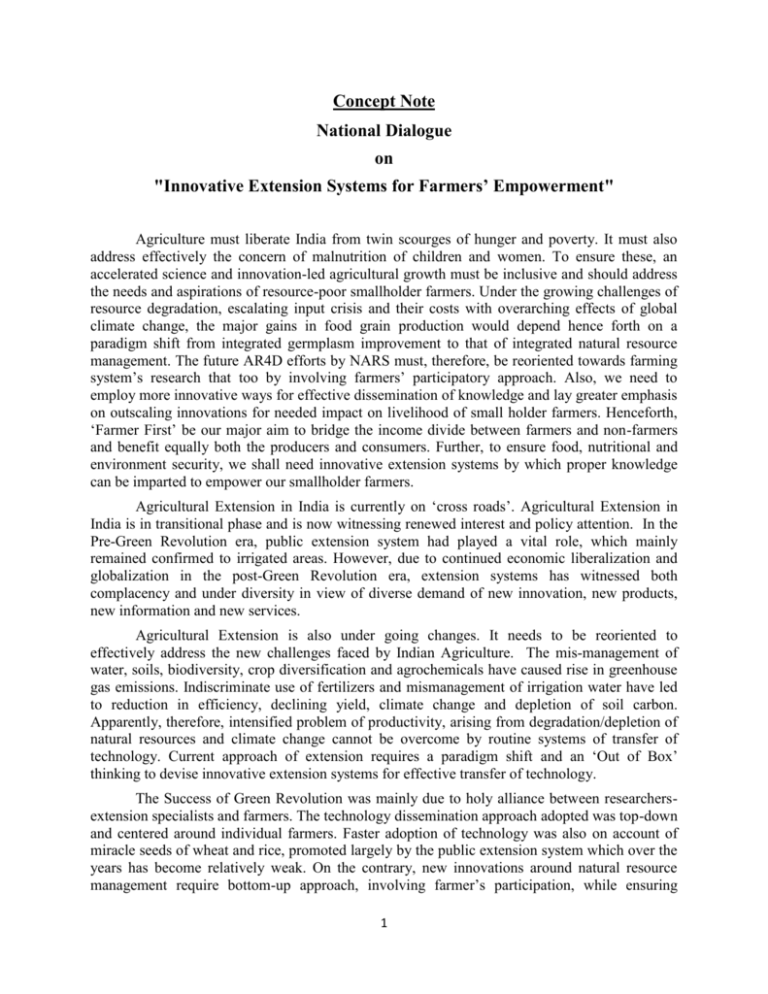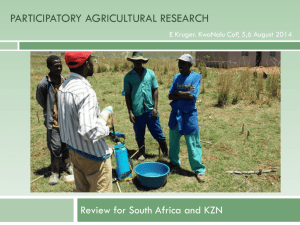National Dialogue on “Innovation Extension Systems for Farmers
advertisement

Concept Note National Dialogue on "Innovative Extension Systems for Farmers’ Empowerment" Agriculture must liberate India from twin scourges of hunger and poverty. It must also address effectively the concern of malnutrition of children and women. To ensure these, an accelerated science and innovation-led agricultural growth must be inclusive and should address the needs and aspirations of resource-poor smallholder farmers. Under the growing challenges of resource degradation, escalating input crisis and their costs with overarching effects of global climate change, the major gains in food grain production would depend hence forth on a paradigm shift from integrated germplasm improvement to that of integrated natural resource management. The future AR4D efforts by NARS must, therefore, be reoriented towards farming system’s research that too by involving farmers’ participatory approach. Also, we need to employ more innovative ways for effective dissemination of knowledge and lay greater emphasis on outscaling innovations for needed impact on livelihood of small holder farmers. Henceforth, ‘Farmer First’ be our major aim to bridge the income divide between farmers and non-farmers and benefit equally both the producers and consumers. Further, to ensure food, nutritional and environment security, we shall need innovative extension systems by which proper knowledge can be imparted to empower our smallholder farmers. Agricultural Extension in India is currently on ‘cross roads’. Agricultural Extension in India is in transitional phase and is now witnessing renewed interest and policy attention. In the Pre-Green Revolution era, public extension system had played a vital role, which mainly remained confirmed to irrigated areas. However, due to continued economic liberalization and globalization in the post-Green Revolution era, extension systems has witnessed both complacency and under diversity in view of diverse demand of new innovation, new products, new information and new services. Agricultural Extension is also under going changes. It needs to be reoriented to effectively address the new challenges faced by Indian Agriculture. The mis-management of water, soils, biodiversity, crop diversification and agrochemicals have caused rise in greenhouse gas emissions. Indiscriminate use of fertilizers and mismanagement of irrigation water have led to reduction in efficiency, declining yield, climate change and depletion of soil carbon. Apparently, therefore, intensified problem of productivity, arising from degradation/depletion of natural resources and climate change cannot be overcome by routine systems of transfer of technology. Current approach of extension requires a paradigm shift and an ‘Out of Box’ thinking to devise innovative extension systems for effective transfer of technology. The Success of Green Revolution was mainly due to holy alliance between researchersextension specialists and farmers. The technology dissemination approach adopted was top-down and centered around individual farmers. Faster adoption of technology was also on account of miracle seeds of wheat and rice, promoted largely by the public extension system which over the years has become relatively weak. On the contrary, new innovations around natural resource management require bottom-up approach, involving farmer’s participation, while ensuring 1 confidence building among farming communities to take risk and make agriculture more scientific and resilient. In the process, sharing of knowledge on good agricultural practices, without dissemination loss, and incentives for critical inputs becomes highly crucial to achieve future successes. Also partnership among key stakeholders become essential to promote growth in agriculture. In the process, care is also needed to overcome complacency that has crept in the public extension/advisory services. Also, a paradigm shift is needed from present national agricultural research institute (NARI) system to that of the national agricultural research and extension system (NARES). This would require active involvement of stakeholders such as farmers, NGOs, private sector, scientists and policy makers. Another paradigm shift has to be in the extension approach towards translational research in order to ensure outscaling of innovations for greater impact on both higher productivity and income. In this context, extension approach has now to be around farming communities rather than individual farmers. Also, Natural Resource Management (NRM) related innovations would require more lead time to assess the impact on farmers fields, unlike the impact of high yielding varieties on crop productivity. This obviously throws a new institutional challenge for needed reforms in existing extension system, which is mostly dependent on public organizations. Role of private sector, especially through involvement of youth and gender in agriculture, becomes most relevant in the present situation. Hence, empowering youth (both men and women) through vocational training and building a cadre of ‘Technology Agents’ to provide technical backstopping as well as custom hire services to the smallholder farmers will go a long way in linking research with extension for accelerating agricultural growth. In other words, we need to link now ‘land with lab’, the ‘village with institute’ and ‘scientists with society’ to ensure faster adoption of resource saving technologies that would benefit both producers and consumers. In the process, the Agriculture Technology Agents will become “job creators and not job seekers” and provide on farmers door steps the best technologies as well as quality inputs. Another strategy could be to create ‘Agri-clinics’, where technology agents could join hands to ensure single window system of advisory services so that farmers need not run from pillar to post. In fact, a good farmer is more knowledge hungry and not dependent only on government subsidy. Pluralistic Extension and Stakeholders In the changing socio-economic environment, there has been steady improvement in the information and communication technology, rural infrastructure and literacy standards in the rural communities. Public sector institutions such as Central and state Government line departments of Agriculture, Horticulture, livestock including fisheries, central and state agricultural universities, network of Krishi Vigyan Kendras (KVKs) and Agricultural Technology Management Agencies (ATMAs) are empowering farmers, but due to the nature and scope of agricultural extension, these are undergoing fundamental changes and hence, a mix of public-private sector participation is required for the efficient delivery of agro-services. Emergence of private sector institutions such as corporate organisations, community based organizations, farmer associations, farmer cooperatives, self-help groups, watershed and water user associations, producer companies, NGOs, farmer producers, input providers (seeds, nutrients, pesticides) service providers (implements etc.), para professional (Kisan Mitras etc) 2 input producers, private corporate sector, fertilizer companies, marketing firms, processing enterprises etc., is a welcome development. There is a need for involving all stakeholders for transforming subsistence agriculture to agri-business and market driven. These extension systems aim at effective delivery and dissemination to the target clientele, promotion of famers’ innovations for income sustainability, challenges related to agro-forestry, natural resource management, women empowerment, gender mainstreaming, promotion of self-help groups, enhancing efficiency in rainfed agriculture and organic farming. It is necessary to empower smallholder farmers by recognizing and promoting their local knowledge and develop farm innovations and their upscaling and out-scaling after validating them, as these innovations are highly cost effective and adopted by the farmers. Smallholders depend primarily on other progressive farmers, input dealers, and radio programs on information broadcasting. Present extension system continues to have the major focus on commodity production in well endowed regions and the extension process is supply driven approach in contrast with demand driven approach. The demand of farmer is changing owing to a variety of technologies and services to remain competitive and profitable, diversify production, produce for niche markets and move to high value products with enhanced production. There is an urgent need to make the demand driven approach as the basis for research and extension. Research and extension system need to adopt an integrated farming system approach, and also there is a need for convergence among different government sponsored programmes for improvement of land, water productivity , effective technology adoption. Innovative extension strategies and models need to be analysed and synthesised. Pluralism in delivery and advisory services with concerns for collaboration, convergence and synergy has to be improved. Objectives In view of above, it has been decided to organize a three days national seminar for sharing experiences among researchers, extensionists and farmers to develop a Roadmap for innovative agricultural extension systems for effective technology transfer. Broad themes 1. Empowerment of small holder farmers 2. Outscaling of farmer-led innovations 3. Farming system approach and diversification for profit maximisation and risk minimisation 4. Farmer based organisations for effective production and marketing. 5. ICT mediated and other communication strategies and models for effective extension systems. 6. Entrepreneurship development for youth empowerment 7. Public-private partnership for promoting innovative agriculture extension system 3 Organizers: 1. Trust for Advancement of Agricultural Sciences 2. Indian Council of Agricultural Research 3. Department of Agriculture & Cooperation Co-sponsors: 1. Private Organisations: ITC, RML, IKSL, mKRISHI, Digital Green, Farmers, 2. Voluntary Organisation: SEWA, BAIF, PRADAN 3. Agri-Input Suppliers: Jain Irrigation, Danuka Seeds, MAHYCO 4. Funding Agencies: DBT, DST, NABARD, Bill & Melinda Gates Foundation 5. Media Partners: DD Kisan Channel, ETV, Rajya Sabha Channel, The Hindu, Business Standard 6. Bharat Krishak Samaj 7. Farmer Producer Companies: Maha Grapes, Maha Anar Suggested Stakeholders Interactions 1. Participatory Video Production: Digital Green 2. Mobile Agro Advisory Services: mKisan, IKSL, RML, Direct2Farm 3. Frontline Extension: Outstanding KVKs 4. Mainline Extension: Outstanding ATMAs 5. Farm correspondents: The Hindu 6. Community Radio: Outstanding CRS run by NGO, GBPUAT 7. Farm Professors, Farm innovators 8. Awardee farmers: IARI, ICAR, SAUs 9. Rural women employment: SEWA 10. Livelihood enhancement: NABARD 11. Corporate Social Responsibility: ASSOCHAM 12. Financial Inclusion of marginal farmers and agricultural labourers: Syndicate Bank, SBI, PNB 13. Self Help Group: NABARD 14. Skill Development of farm youth: Agriculture Sector Skill Council of India (ASCI) 15. Digital India: Department of Electronics & Information Technology (DeitY) 4





